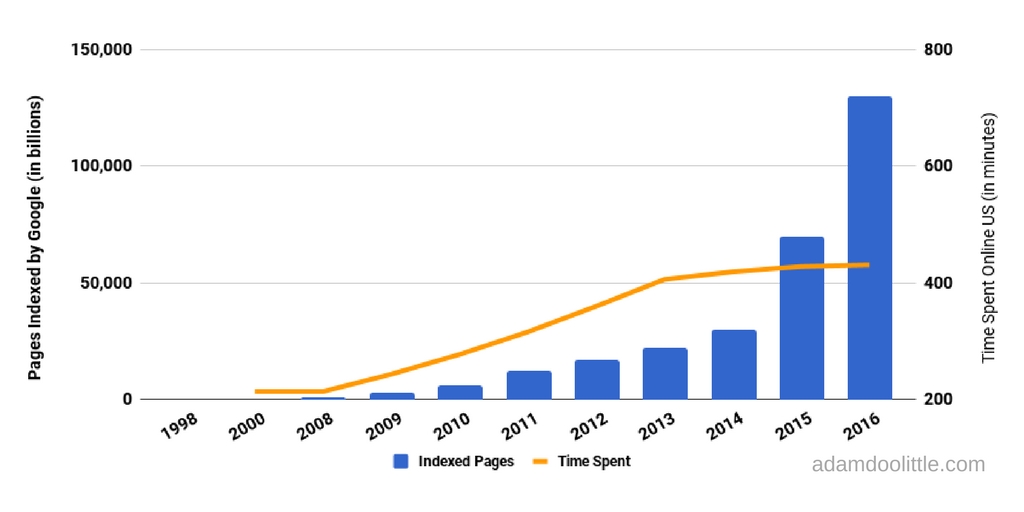Red Ocean. Blue Ocean. The choice is yours. Like Morpheus offering Neo a choice: Red Pill or Blue Pill. The red ocean is bloody. It’s filled with bench-marking, fighting for a smaller and smaller portion of an already shrinking pie. It’s insanely competitive.
“Competition is for Losers” — Peter Thiel
Or there’s the blue ocean. The blue ocean is redefining the competition and making them irrelevant. It’s growing the overall pie and winning big. It’s about creating entirely new markets free of competitors.
In 2001, China entered the World Trade Organization. Since then the world has experienced a glut of supply. The entire world has become a red ocean where we’re all swimming in bloody, strong currents. It’s hyper competitive today. And it’s not going to get any less competitive–most likely more competitive in the future.
“Our study shows that blue ocean strategy is particularly needed when supply exceeds demand in a market. This situation is applying to more and more industries today and will be even more prevalent in the future.” — W. Chan Kim
Blue Ocean Strategy isn’t a one time move. It’s a dynamic process that continuously adapts to the changing value delivery of competitors. Eventually all strategic moves are imitated by competitors. The constant, natural tendency shows markets move towards red oceans. Therefore, Blue Ocean Strategy isn’t a one-time solution but a thought process to monitor the landscape and adapt when necessary.
Blue Ocean Strategy Vs. Porter’s Competitive Strategy
Porter’s Trade off between Value and Cost vs. Blue Ocean Shift to New Markets
Porter’s Five Forces model looks at the current market and allows the company to make a choice: Be the Cost leader or Differentiate and compete on value. It looks at the current market structure and where best a company could compete given that structure.
Market-competing moves (Porter) are red oceans. On the other hand, Market-creating moves are blue oceans.
Red Oceans are all the current industries in existence today. It’s where most organizations fight over market-share. Blue oceans are all the industries yet to be created. Blue Oceans area also where profit and growth increasingly come from.
Porter’s Competitive strategy makes a trade off between pursuing a low cost strategy or a differentiation strategy. Blue Ocean Strategy breaks this trade off in terms of the kind and type of value created. It’s how new markets are created by pursuing both lower costs and differentiation. This is how companies create new market space. Exciting competitors on the value-cost frontier are irrelevant for the company that created the new market space.
Blue Ocean Strategy:
Blue Ocean Strategy is about looking beyond the traditional customers of a given industry. It’s about creating a product that competes with the alternatives. Southwest Airlines didn’t compete with all the other airlines for air travelers. They created a product that competed with the convenience and low cost of driving. Yellow Tail didn’t compete with all the other California wines. They created a product for non-wine drinkers. Yellow Tail used Positioning to create an area uncontested.
To create blue oceans, look to non-traditional consumers and think about creating a product that competes with the alternative. There are four angles to view and work through: Reduce, Eliminate, Create, and Raise.
The Four Action Framework:
Four Action Framework
Blue Ocean Shift: Beyond Competing with Proven Steps to Seize New Growth
In Blue Ocean Shift, the focus switches from ‘what is a blue ocean?‘ to ‘how do teams actually apply the theory and tools to shift from the read to blue ocean?‘. There’s three key components for a successful shift.
- Adopting a blue ocean perspective — organizations open to Blue Ocean Strategy think different. They ask different questions. They innovate in different ways. They approach the value-cost frontier differently. It’s an expanded field of view.
- Practical tools for market creation — these tools help challenge assumptions. They help identify new customers, new sources of demand that others miss or dismiss. It’s a guide to building the right team to implement the shift.
- Having a Humanistic process — Culture, people, processes are all working to maintain the status quo (against a Blue Ocean Shift). It’s the internal friction in trying to change to a blue ocean be it political, structural silos or infighting. Making sure the shift includes processes to ease the humanistic side allow stronger execution.
Get Both Books
Blue Ocean Strategy introduces the idea, tools and case studies to start thinking about blue ocean strategy. It starts the journey into less competitive waters with more growth and profit. Building on the ideas, Blue Ocean Shift deals with what you need to make the shift into blue oceans. It deals with a deeper dive into the strategy, the tools, and more important what it takes on the human side to execute a successful shift into a blue ocean.

